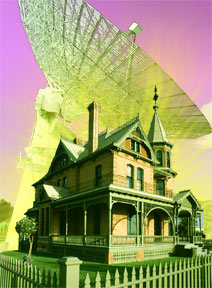
Community associations were once free to adopt and enforce restrictions and regulations on satellite dishes and other types of antennas. Following the enactment of the Telecommunications Act of 1996, federal law preempted all state, local and other non-governmental restrictions regulating satellites and antennas, thus, the landscape for community and condominium associations was significantly changed. In October 1996, the Federal Communications Commission (FCC) adopted the Over-the-Air Reception Devices Rule (OTARD rule or rule) concerning governmental and non-governmental restrictions on viewers' ability to receive video programming signals from direct broadcast satellites ("DBS"), multi-channel multi-point distribution (wireless cable) providers ("MMDS"), and television broadcast stations ("TVBS").
OTARD Rule Prohibitions
The OTARD rule prohibits entities, such as community associations, from creating restrictions that impair the installation, maintenance or use of antennas used to receive video programming. It applies to video antennas including direct-to-home satellite dishes that are less than one meter (39.37") in diameter (or of any size in Alaska ), TV antennas, and wireless cable antennas. The OTARD rule prohibits restrictions that: (1) unreasonably delay or prevent installation, maintenance or use; (2) unreasonably increase the cost of installation, maintenance or use; or (3) preclude reception of an acceptable quality signal. Since its adoption, the FCC has amended the rule so that it also applies to rental property and to customer-end antennas that receive and transmit fixed wireless signals.
The OTARD rule applies to viewers who place antennas that meet size limitations on property that they own or rent and that is within their exclusive use or control, including condominium owners and cooperative owners, and tenants who have an area where they have exclusive use, such as a balcony or patio, in which to install the antenna. The OTARD rule applies to town homes and manufactured homes, as well as to single family homes. The rule does not apply to antennas for AM/FM radio, amateur HAM radio or Internet.
The OTARD rule allows local governments, community associations and landlords to enforce restrictions that do not impair the installation, maintenance or use of the types of antennas described above, as well as restrictions needed for safety or historic preservation. Under some circumstances, a community association or landlord can restrict the installation of individual antennas if a central or common antenna is available. The OTARD rule does not apply to common areas that are owned by a landlord, a community association, or jointly by condominium or cooperative owners. Common areas may include the roof or exterior wall of a multiple dwelling unit. Therefore, restrictions on antennas installed in or on such common areas are enforceable.
Restrictions that do not impair a viewer's ability to receive video programming services remain enforceable, as do safety rules and rules in certain historical districts, even if such rules impair reception. As a result, community associations may still require an owner to comply with rules governing the means, method, and location of the antenna installation, as long as no unreasonable delay or cost is involved and an acceptable quality signal can be obtained. Such restrictions might include requiring compliance with building codes, screening, unobtrusive placement, painting certain parts of the antenna, camouflage, and other reasonable steps to ensure the safety of the installation and minimize the visual effect on the community. The FCC rule is limited in its application to antennas installed on property within the exclusive use or control of the viewer or in which the viewer has a direct or indirect ownership interest. In other words, the OTARD rule does not authorize antenna installation on common property or areas unless the owner has exclusive control or use of the property, such as a balcony or patio, since these are often limited common elements reserved for the exclusive use of the unit owner.
FCC Criteria for Improper Restrictions
There are three criteria used by the FCC in determining whether an association restriction impairs an owner or viewer's ability to access satellite or antenna signals. A restriction impairs a viewer's ability to receive signals if it: (1) unreasonably delays or prevents installation, maintenance or use of; or (2) unreasonably increases the cost of, installation, maintenance or use of; or (3) precludes a subscriber from receiving an acceptable quality signal from one of these antennas. The rule does not prohibit restrictions that merely affect a viewer's ability to receive signals as long as the restrictions do not impair. Therefore, architectural restrictions that affect but do not impair a viewer's ability to receive signals are permissible.
Restrictions that unreasonably delay or prevent installation, maintenance or use of an antenna are also prohibited. Any restriction or covenant that prohibits all antennas would prevent users from receiving signals and is prohibited by the OTARD rule. Procedural requirements imposed by an association can also impair the ability to receive service. The FCC has found that approval processes of the location of the antenna, even if expedited, cause an unreasonable delay. In addition, any type of administrative fees imposed is an unreasonable cost. Therefore, an association cannot charge a fee for reviewing notification forms or monitoring compliance with any guidelines it has established.
Restrictions preventing a homeowner from receiving an acceptable quality signal are prohibited. A requirement that an antenna be placed in a position where reception would be impossible or would be substantially degraded would be conflict with the FCC rule. In contrast, an association regulation that requires antennas be placed to the extent feasible in a location not visible from the street would be permitted if the placement allows reception of an acceptable quality signal, and does not unreasonably delay or increase the cost of installation, maintenance or use. Delay and increased cost are valid justifications for installing an antenna in a non-preferred location, even if an acceptable quality signal may be obtained in the preferred location.

Permissible Restrictions
There are some permissible restrictions against satellite dishes and antennas. If there are legitimate safety concerns, restrictions are permitted, even if they impair reception or delay or increase the cost of installation, maintenance or use of the antenna. An association can enforce a safety restriction while the FCC reviews the validity of the restriction. Valid safety restrictions include preventing people from installing antennas on fire escapes, restrictions requiring that a person not place an antenna within a certain distance from a power line, electrical code requirements to properly ground the antenna, restrictions prohibiting installation at a location that will obstruct a driver's view of an intersection or street, and installation specifications and requirements that describe proper methods to secure an antenna.
The safety reason for the restriction must be written in a document that is readily available to antenna users prior to installation, so that a person wanting to install an antenna knows what restrictions apply. The restriction cannot impose a more burdensome requirement than is needed to ensure safety. In addition, the restriction must explain the reason for the safety concern. A safety restriction will not be valid without a specific explanation of the need for a safety restriction.
Restrictions in historic areas may also be valid. Because certain areas are considered uniquely historical and strive to maintain the historical nature of their community, these areas are exempted from the Rule. To qualify as an exempt area, the area must be listed or eligible for listing in the National Register of Historic Places. In addition, the area cannot restrict antennas if such a restriction would not be applied to the extent applicable in a non-discriminatory manner to other modern structures that are comparable in size, weight and appearance and to which local regulation would normally apply. Valid historical areas cannot impose a more burdensome requirement than is needed to ensure the historic preservation goal.
Another permissible restriction for an association may require residents to comply with a notice or registration process. For routine installations, a simple notification form could be required, indicating the type of antenna to be installed, the site, method and manner of antenna installation anticipated. For non-routine installations, such as when a valid safety restriction would be violated by the installation, an explanation could be required on a form outlining why the antenna must be sited in this area/manner. Although an association can adopt rules detailing preferred locations, a satellite or antenna user can install an antenna in a non-preferred location without seeking approval, unless there is a valid safety or historic preservation concern, if installation in a preferred location would be impaired.
Condominium Restrictions
As for condominium associations, owners can install an antenna on balcony or patio if the patio or balcony is a limited common element, restricted for the owner's exclusive use. Again, installation rules would be permissible and may require that the owner cover the antenna as long as such a requirement does not impair an owner's ability to receive a signal or unreasonably delay or increase the cost of installation, maintenance or use.
When a conflict arises concerning the validity of a restriction, the local government, community association, property owner, or management entity that is trying to enforce the restriction has the burden of proving that the restriction is valid. This means that no matter who questions the validity of the restriction, the burden will always be on the entity seeking to enforce the restriction to prove that the restriction is permitted under the rule or that it qualifies for a waiver.
In light of the rapidly changing technology in telecommunications, it is important for you to stay informed on these types of issues faced both by homeowners and community associations. You can find more information about the FCC rules governing satellites and antennas at www.fcc.gov.
Note: Condominium boards have the right to prohibit residents from attaching the dish or any appurtenant equipment to the limited common element such as walls or fence boards. Further, the limited common element is defined as the airspace contained within the plan bounded by the top of the fence or railing, meaning that boards may prohibit condo owners from installing a dish above the fence line or through the pickets.
For more information see the FCC Fact Sheet on Placement of Antennas.
 Print
Print Email
Email







